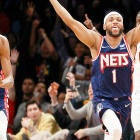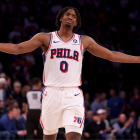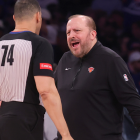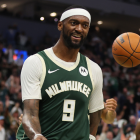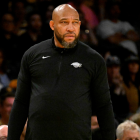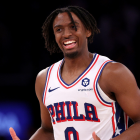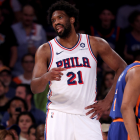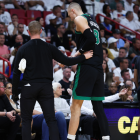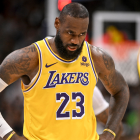
NEW YORK -- With his defender's eyes on Kevin Durant, the Brooklyn Nets' Bruce Brown tried to sneak behind him. This kind of cut is often easy money for Brown and the Nets, but this time he caught the ball without a clear lane to the basket or an obvious assist opportunity. He patiently Nashed along the baseline, channeling his coach, and improvised a dribble-handoff with Durant.
Brown's defender, Cedi Osman, abandoned him to swarm the superstar, and then came the easy money: short roll, lob to Nicolas Claxton, dunk.
This is Brooklyn basketball. Durant and Kyrie Irving attract attention, and the role players capitalize on it. In Tuesday's play-in game the Cleveland Cavaliers took an "extreme" approach, as Steve Nash put it, but the Nets have spent months dealing with defenses that cheat off Brown and their bigs.
"If you do cheat, you might as well go ahead and double-team off of them because Kevin's so long and he's going to be all over it," Detroit Pistons coach Dwane Casey said. "You double-team him, he's a very willing passer. Kyrie's an excellent passer. So those guys, if you do double-team, they're most likely going to cut out of the corners and cut out of the slot, so you gotta be ready for that."
The Nets are not the Golden State Warriors, who remain the gold standard when it comes to creating space -- and confusion -- with ball movement, screening and speed. Just like when Durant was in the Bay Area, though, his team starts three of the best shooters who have ever lived, alongside a Swiss Army Knife and a low-usage big man, neither of whom has much shooting gravity. Particularly since trading James Harden, Brooklyn has needed to be Warriors-like.
"Obviously," Nash said, "the ideal scenario is to have five elite shooters," but there have been many times when "we just haven't had enough shooters in the lineup, so we tried to find different ways to make the non-shooters -- or the slashers, so to speak -- effective, and still be able to put the defense in difficult positions.
"It's clearly much easier to have shooting at every position or four out of five. Having three elite shooters is better than maybe four average shooters, but it's really about how you make it work, how you can design a philosophy and a system that still makes everybody a threat in the best way possible."
Irving missed 65 percent of the regular season because he is not vaccinated. Durant missed about a third of it, mostly because of a knee injury, which meant that the Nets played only 13 percent of their minutes with both on the court and 34 percent with neither. Joe Harris, their only constant since the days of the BrooklyKnight, injured his ankle less than a month into the season and has been out ever since. At the end of the season, their most used lineup (171 minutes) had Harris, Harden and the since-benched Blake Griffin in it. Brooklyn still finished with the eighth-best offense in the league, per Cleaning The Glass.
When the post-Harden Nets have had three of Durant, Irving, Curry, Patty Mills and Goran Dragic (i.e. the shooters) on the floor, plus two of Brown, Claxton, Andre Drummond and Kessler Edwards (i.e. the rest of the expected playoff rotation), they have scored 124.5 points per 100 possessions with a plus-12.4 point differential, per PBPstats. The numbers are even better in a small sample with only two shooters.
Entering their first-round series against the Boston Celtics, it's worth wondering whether or not Brown should still be considered a non-shooter. He dedicated much of last summer to improving his jumper, but shot just 31.7 percent from 3-point range before the All-Star break, attempting fewer than Draymond Green on a per-minute basis. After the break, Brown shot 3s about twice as frequently and made 47.2 percent of them. "They're still playing me the same exact way," Brown said, so he plans to keep shooting when he's open. Edwards is shooting 40 percent since the break, too, and will be encouraged not to hesitate.
Like the rest of Brooklyn's role players, though, Brown and Edwards are most dangerous on the move. When the Nets are late in the shot clock or they're hunting a mismatch, they isolate Durant or Irving, "but that's not the plan," Nash said. The plan is "to bring players into the action so that we give the defense decisions to make, we ask questions of the defense, we see if they make a mistake." Rather than standing around and watching Durant and Irving, Brooklyn wants to create slight advantages for them.
When the Nets' offense is humming, it looks incredibly simple: There are deadeye shooters on the perimeter, and everybody else's job is to free them up. Brown, Drummond and Claxton are wildly different players, but they're doing a lot of the same stuff: sprinting into dribble handoffs, setting high ball screens, screening away from the ball.
"If the big is in the paint and I have Patty, Seth, K or Ky at the 3-point line, I can screen their man and they'll be wide open," Brown said.
Smart players have known this for decades. Ben Simmons has created countless 3s this way, in addition to all of the kickouts and transition attempts. This is the best reason for optimism about integrating him. If Simmons is able to return from his back injury against Boston, he should only be additive: Another playmaker, another roller and an enormous, desperately needed boost on defense, the boards and the break.
Curry, who played with Simmons in Philadelphia, said that the adjustment would be smooth: "You don't have to call plays for him. He can just fit in and do what he does." If defenses couldn't stop the Curry-Simmons two-man game last year, imagine it with Durant and Irving and/or Mills on the other side of the court.
Brown and Claxton closed the play-in game, and it wasn't the first time Nash had gone that route. Without Simmons, it's how he can maximize the team's defensive versatility. In Brown and Claxton's 325 minutes together, Brooklyn has a plus-13.9 point differential and an elite defense. That alley-oop against Cleveland was a result of them working on playing off the stars without getting in each other's way.
"I touch on that a lot with film," Claxton said. "Just making sure that I'm available. I'm going to be in the dunker area around the paint, but I can move and get myself open like that for lobs or drop-offs and that's easy money for me."
Those opportunities will be harder to come by when the Nets' first-round series starts Sunday, not only because they're facing a stifling defense but because they're facing a switch-heavy one. Even without All-Defense candidate Robert Williams III, the Celtics' aggressive switching baits teams into slowing down and getting stuck in mud.
"They're doing an amazing job," Dragic said. "Especially the guy who is coming to screen, they push him up and then they switch. They kill that trigger. Most of the teams, they're not getting those triggers and they get flat on offense."
Dragic said that this makes it more important for the ball-handler to set up his defender and for the screener to "come up with a motor" and angle the screen to create separation. Shooters can set ghost screens and pop to the perimeter. Rollers can slip behind defenders into open space. Offensive rebounders can punish smaller players.
Nash wants all of that, but he doesn't want the players to overthink. Against switching, against zone, against conventional defense, Brooklyn's philosophy is the same: Make quick decisions, keep moving, trust one another.
"I think the pockets will be there," Brown said. "A lot of slips. K or Ky can shoot behind the screens. There's a lot of different things we can do."
Brown was right when he said Williams' absence will make it easier to attack Boston's other bigs, even though Durant didn't appreciate the comment. And if the defense loads up on Durant and Irving, "I can cut," Brown said. "I can do other things. I won't just stand there. I'll figure out what I need to do to make an impact." The last time these teams met, on March 6 at TD Garden, Brown had 16 points on 6-for-10 shooting, plus five assists, and the Nets scored 118.8 points per 100 possessions.
"Those guys, they're such smart players," Milwaukee Bucks coach Mike Budenholzer said. "They know how to impact the offense, they know how to do things that are freeing those guys and creating good [looks]. It's different spacing and different actions, the DHOs and the cutting and things like that. They're a very, very good offensive team."
The Celtics won that game in March, though, because Brooklyn couldn't get enough stops. Everything that the Nets have done to work around their spacing issues merely gives them a chance to make up for their small backcourt and lack of 3-and-D guys. As Durant said of Brown's early analysis, it's not going to be easy.













